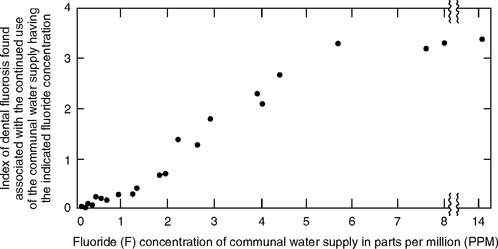17 Measuring Dental Fluorosis
This chapter describes methods for measuring dental fluorosis. Dental fluorosis is a hypomineralization of the dental enamel caused by excessive ingestion of fluoride during tooth development.13 Depending on the quantity and timing of fluoride ingestion during this period, the clinical appearance of fluorosis can range from barely noticeable changes to an ugly brown stain with pitting and flaking of friable enamel.
DEAN’S FLUOROSIS INDEX
An index of fluorosis was needed when the initial investigations of fluorosis began in the 1930s (see Chapter 22). Dean’s first Fluorosis Index set criteria for categorizing dental fluorosis on a seven-point ordinal scale: normal, questionable, very mild, mild, moderate, moderately severe, and severe. Dean used this seven-point scale for his Fluorosis Index for some years,3,8 but by 1939 his experience led him to combine the “moderately severe” and “severe” categories into a single “severe” category.9 By 1942 Dean had revised his Fluorosis Index into a six-point scale, including normal or unaffected enamel,4 that still finds some use today. Dean’s criteria for his revised version of the Fluorosis Index are shown in Box 17-1.
A spin-off of the Fluorosis Index was the Community Fluorosis Index (CFI), which Dean defined in 1935 by assigning arbitrary numerical values to his seven-point ordinal scale, again ranging from no fluorosis and borderline to severe and very severe.6 Fig. 17-1 shows the distributional data from 10 communities7 on which he based the CFI. Dean related this index to the concentration of fluoride in a water supply and was able to show a linear correlation, as one of his original charts demonstrates (Fig. 17-2). Dean also stated, although only in a footnote, that CFI scores below 0.4 were of “no public health significance.”5 With cosmetic awareness likely to be greater now than it was in the 1930s, however, Dean’s personal assessment of the public health significance of fluorosis may be less relevant today.
TOOTH SURFACE INDEX OF FLUOROSIS
Fluorosis was the subject of surprisingly little study after the initial investigations of controlled water fluoridation21 until the 1980s, when research was spurred by suggestions that its prevalence might be increasing.16 During the 1980s, the Tooth Surface Index of Fluorosis (TSIF) was developed and used by researchers at the National Institute of Dental Research.10,15 Criteria for the TSIF are shown in Box 17-2. The TSIF scale is probably more sensitive than Dean’s index in identifying the mildest forms of fluorosis. The TSIF ascribes a score on a scale of 0-7 to each tooth surface in the mouth, whereas Dean’s index applies only to the two most affected teeth in the mouth. The World Health Organization, however, still recommends use of Dean’s Fluorosis Index in its basic survey manual.26 TSIF results are given as an ordinal distribution rather than as mean scores.
BOX 17-2 Clinical Criteria and Categorizations for the Tooth Surface Index of Fluorosis15
Stay updated, free dental videos. Join our Telegram channel

VIDEdental - Online dental courses




